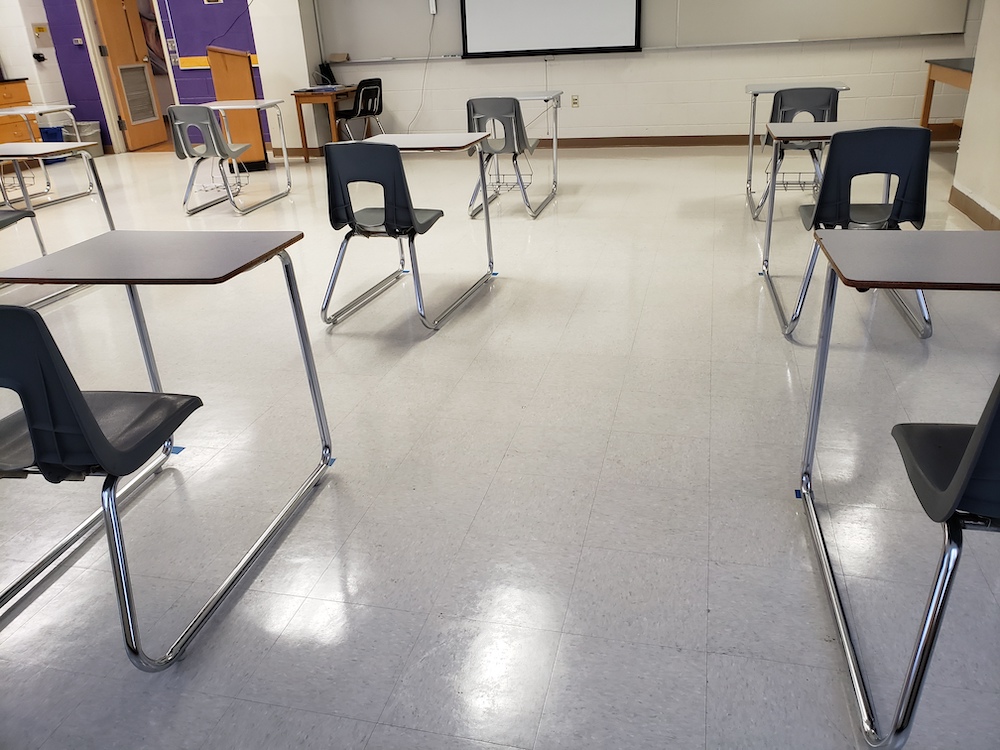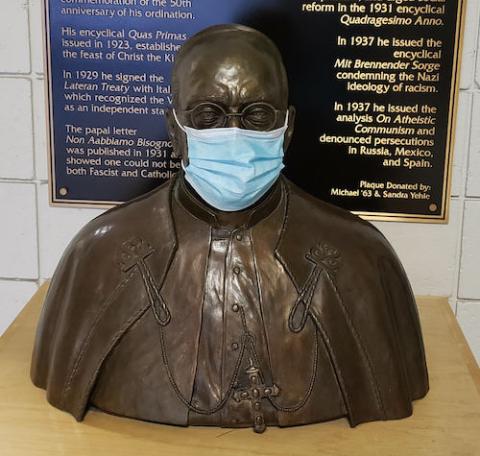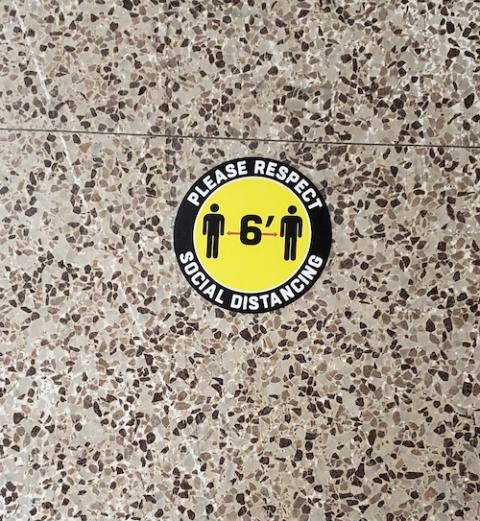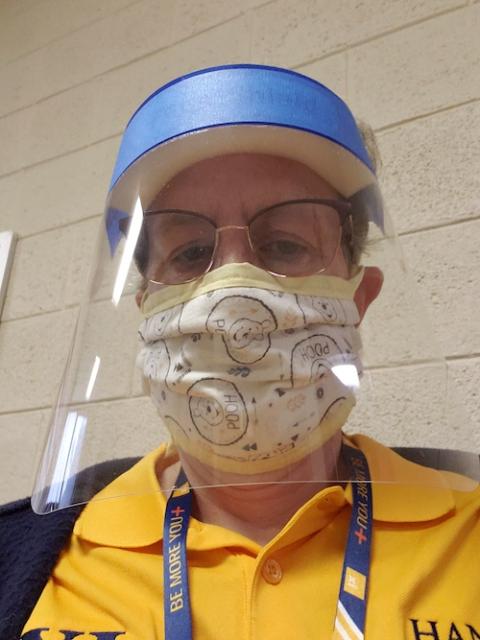
Tables have been replaced by desks that all have to face the same direction; all extra furniture and personal touches have been placed into storage. (Jane Marie Bradish)
Editor's note: Celebrate Catholic Schools Week is Jan. 31 through Feb. 6, 2021.
My shoes and eyeglasses stay in a plastic bin in the garage along with my school keys and ID. My reusable lunch bag has been replaced by disposable brown paper bags. The community pendant that I've worn daily for 30-plus years sits on my dresser next to an unworn wristwatch. I enter the back door of my residence and continue two steps ahead, directly to the basement where I strip down, wash my hands and face in the stationary tub, and come back upstairs for a shower. This is the new end of the work day routine in my life, I'm a teacher in the COVID-19 era.
With our school shuttered on March 16, 2020, my school administrative team has worked hard ever since to develop reopening plans for our students and staff. Everyone's health and safety were the driving force behind the planning, and it was a given that we would not reopen unless it was as safe as possible. The entire building was sanitized, fogged and ozone treated. Fast forward to the 2020-2021 school year — no one enters the building without a temperature and symptom check, every single time. Masks are non-negotiable. Each teacher has gloves, rags and a spray bottle of cleaner to use on every surface after each class. Tables have been replaced by desks that all have to face the same direction; all extra furniture and personal touches have been placed into storage.
The return to school required the approval of a 30-page plan submitted to our local health department. It includes protocols and procedures for screening, cleaning, movement throughout the building, food service, ventilation, physical distancing, what would be done if there was an exposure or a positive test, and so forth.
Advertisement

Everyone at the school is following pandemic safety precautions. (Provided photo)
Our school information system developed a daily symptom checker as well as contact tracing reporting in case of exposure. We have a special COVID-19 phone number to report symptoms, exposure and positive test results, which, in turn have to be reported to the local health department. Every adult was trained in cleaning protocols, and every student was trained for what "new school" would look like.
By law we had to offer an option for 100% virtual instruction, and about one-third of our families selected that. The remaining students were split into two cohorts based on their family name. Our normally bustling building of 1,000 is eerily quiet, with roughly only 250 people in it at a time. Each teacher teaches each section of their classes three times: cohort A-K, cohort L-Z, and cohort virtual.
When students enter a classroom, they wash their hands or use hand sanitizer, every single time. Industrial fans hum to keep air moving. Colorful tape covers the floors to help with physical distancing. The arrival/dismissal from classes is staggered to limit the number of people in the hallways at one time.
Each student comes to our building twice a week and attends half their classes for longer-than-usual periods. The other days, they do their school work from somewhere else, hopefully home, sometimes connecting virtually and sometimes working independently. Late afternoons and Fridays are reserved for office hours for students who need additional instruction or help. On Fridays, there is also time for staff meetings and teacher planning.
I'm learning more about Zoom than I ever wanted to: how to create videos of me presenting material in an empty classroom, and how to use a fussy smartboard that works only when it feels like it. I'm exploring the online resources available, evaluating what might be helpful for my students. Each of my classes has a chat room where students can put questions and help each other, much like we would do if we could be together.

There are reminders in the hallways for safe social distancing. (Jane Marie Bradish)
COVID-19 continues to be a very fluid reality: the positivity rate in my area is four times more than what is considered acceptable. We have to be prepared to switch to 100% virtual instruction for the entire school on a moment's notice. That means figuring out a space I can Zoom from, having all my teaching materials at home, and probably a bunch of other things I haven't thought of yet.
Teaching this way is definitely harder. I like the interaction and energy in my classroom. I like to be able to read the student's faces to see if what we're doing makes sense. I like to be able to answer questions in real time. I like to be able to use all my classroom "toys," taking theory to application. With contact limited to one hour a week — and from at least 6 feet away, there is little time for anything other than presenting lots of material and hoping for understanding.
And, I check on everyone's mental health. Months and months of what I refuse to call "the new normal" have taken a social and emotional toll that's especially hard for adolescents. While adults have missed usual activities and routines, including some very significant ones, we have more coping skills than children and adolescents. I watch my students mourn so many rites of passage that high school brings — activities and events that simply cannot be done virtually.
Yes, we will still have "spirit weeks," but there will be no assemblies to see which teacher/administrator will get a new hairdo compliments of a student fundraiser. It is very possible that graduation will once again be drive-in movie style, with each family in their car watching prerecorded videos of honors and well wishes, as masked and gloved staff deliver shrink-wrapped diplomas.

But with face shield and mask, gloves and bottles of cleaner, and risk of exposure and illness, I return to my classroom. (Jane Marie Bradish)
As I move through the school year, I find myself wondering how I will react if I am exposed to the virus and forced into mandatory quarantine. Will I look to place blame? Will I waste energy trying to figure out "who did this to me," or will I accept the quarantine remembering it is meant to keep people safe and healthy? I don't know, and I hope I don't find out.
I also wonder about becoming infected myself! Being with a couple of hundred people a day, even with all safety protocols in place, puts me at a higher than average risk for contracting COVID-19. There are many horror stories about what this disease does to the human body and spirit, and lots of general unknowns about it and its long-term effects. That's far from a comfortable space for me to live in.
I've been told by well-meaning folks that I need to put my trust in God. Easier said than done. But with face shield and mask, gloves and bottles of cleaner, and risk of exposure and illness, I return to my classroom. I go back each and every day because I am a teacher. I am a teacher who just happens to be in the COVID-19 era.
[Jane Marie Bradish is a member of the School Sisters of St. Francis based in Milwaukee. Her ministry has been in secondary education; currently, she teaches theology and is the academic programmer for a large, urban, multicultural high school.]







